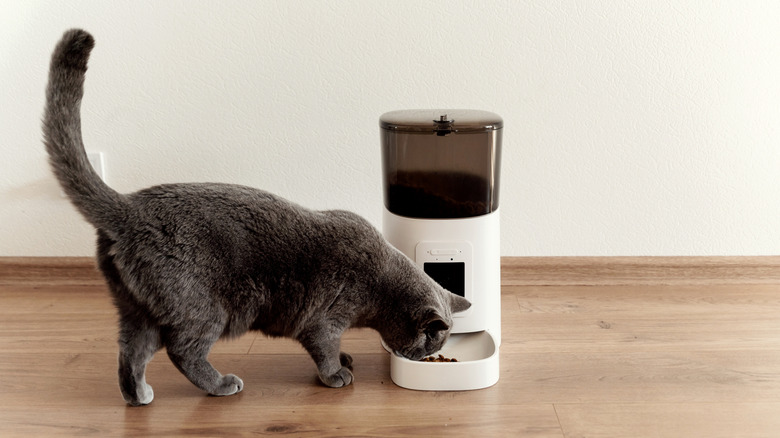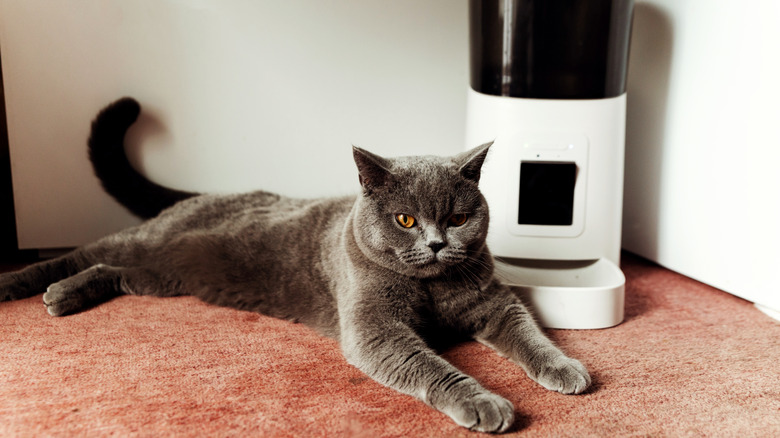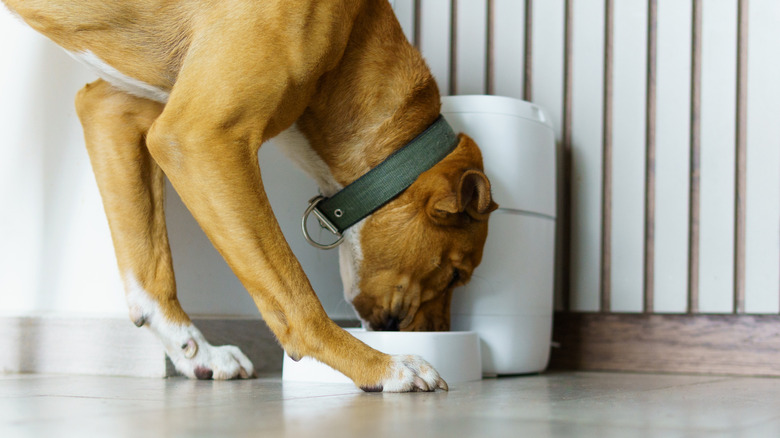Automatic Cat Feeder Pros And Cons - Are They Worth It?
It may seem like a 21st-century invention, but the first patented time-controlled feeding device actually appeared in the 1940s. Now, automatic cat feeders are taking over TikTok and are available in dozens of different styles in pet stores and online. These devices are designed to dispense food at pre-set times once, twice, or several times a day. Some also include a camera, two-way audio, and Wi-Fi, among other nifty features — but are they worth the price? The answer depends on the pros and cons of the model you buy, along with your needs and preferences.
You can find a standard automatic cat feeder, sans bells and whistles, for under $25, while other models that offer high-quality features cost almost $300. This wide range offers the convenience of accommodating both small and large budgets. Maybe you don't want a camera, or perhaps you don't plan on using any type of audio setting. Or, maybe you want a feeder with all of the above, or you need a dual dispenser for two cats that don't like to share. Regardless of which boat you're in, every feeder has a list of pros and cons to consider.
Automatic cat feeders offer convenience, consistency, and portion control
An automatic feeder adds to the many conveniences of being a feline parent. Simply fill the storage tank with food, select the meal quantity, and create a cat feeding schedule, eliminating the need for daily manual feedings. This can be especially beneficial for cat parents who spend extended periods of time away from home or have very busy schedules. Having an automatic feeder can also abolish your cat's need to paw at your face to awaken you or to whine incessantly, demanding to be fed. Instead, you may find it hanging out or pawing at the feeder as meal times approach.
These feeders also provide the benefit of consistency. Many parents who feed their cats manually don't do so at the exact same time every day, especially if they're shift workers. For example, Kitty's breakfast might have to be at 5 a.m. for several consecutive days before shifting to 9 a.m. on others. Using an automatic food dispenser means your cat can have its daily meal(s) at the same time every single day, regardless of your schedule.
Another advantage of automatic cat feeders is portion control. If you want to prevent your cat from overeating or temporarily limit their caloric intake for weight loss, you can determine the food amount for each meal.
Automatic cat feeders can attract unintended eaters
Just as with any other electronic device, an automatic cat feeder can malfunction, which could equate to missed meals; a feeder powered by electricity can fail due to a power outage, and batteries eventually die or degrade. With these possibilities in mind, choose a feeder that offers battery powering and a low food alert, or one that notifies you when meals are dispensed. You can also mark the date that you fill the feeder and the date it completely empties so you can set future fill reminders.
Another potential downside to electronic feeders involves pest attraction. Owners who manually feed their cats often store the food in airtight containers, impenetrable to insects. Automatic cat feeders, however, have small openings that ants and even certain cockroaches can get into, especially if they're placed on the floor. To prevent bugs from sharing your cat's meals, follow the cleaning instructions for the feeder and clean it regularly.
Insects aren't the only uninvited creatures that can help themselves to the kibble in an automatic food dispenser; dogs can, too. If you're also a dog parent, you might want to place the feeder in an area that the non-feline pets can't access. Alternatively, if you have small dogs, place the feeder inside a litter box furniture enclosure in the corner of a room and block the corner with pet gate panels. Your cat will have to jump over the panels to access the feeder, but at least your dogs won't eat the food. Deciding on what works for you, and your cat, can help keep everyone happy.


